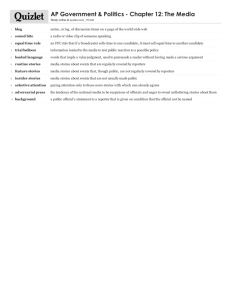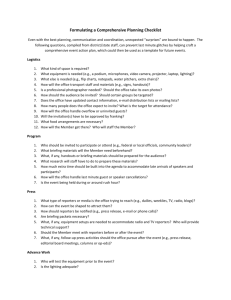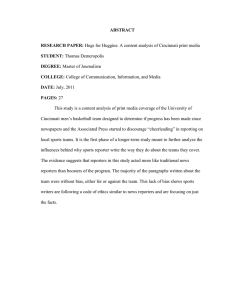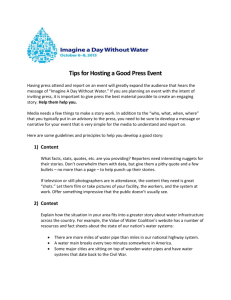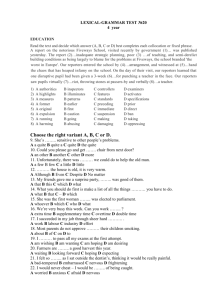MEDIA RELATIONS
advertisement
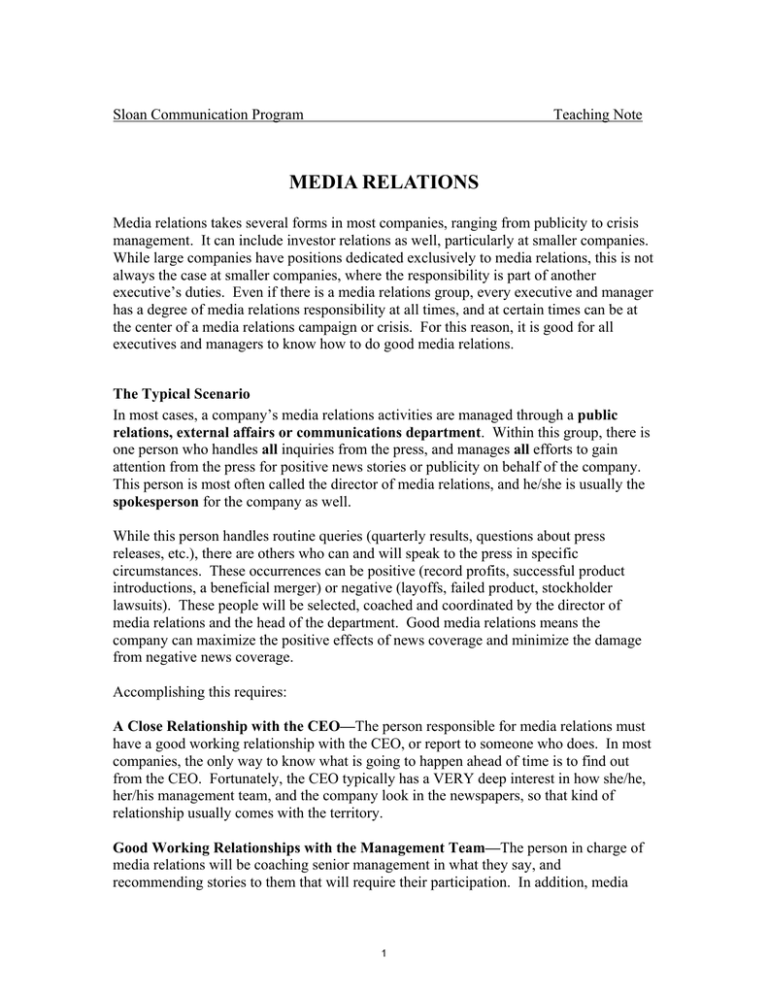
Sloan Communication Program Teaching Note MEDIA RELATIONS Media relations takes several forms in most companies, ranging from publicity to crisis management. It can include investor relations as well, particularly at smaller companies. While large companies have positions dedicated exclusively to media relations, this is not always the case at smaller companies, where the responsibility is part of another executive’s duties. Even if there is a media relations group, every executive and manager has a degree of media relations responsibility at all times, and at certain times can be at the center of a media relations campaign or crisis. For this reason, it is good for all executives and managers to know how to do good media relations. The Typical Scenario In most cases, a company’s media relations activities are managed through a public relations, external affairs or communications department. Within this group, there is one person who handles all inquiries from the press, and manages all efforts to gain attention from the press for positive news stories or publicity on behalf of the company. This person is most often called the director of media relations, and he/she is usually the spokesperson for the company as well. While this person handles routine queries (quarterly results, questions about press releases, etc.), there are others who can and will speak to the press in specific circumstances. These occurrences can be positive (record profits, successful product introductions, a beneficial merger) or negative (layoffs, failed product, stockholder lawsuits). These people will be selected, coached and coordinated by the director of media relations and the head of the department. Good media relations means the company can maximize the positive effects of news coverage and minimize the damage from negative news coverage. Accomplishing this requires: A Close Relationship with the CEO—The person responsible for media relations must have a good working relationship with the CEO, or report to someone who does. In most companies, the only way to know what is going to happen ahead of time is to find out from the CEO. Fortunately, the CEO typically has a VERY deep interest in how she/he, her/his management team, and the company look in the newspapers, so that kind of relationship usually comes with the territory. Good Working Relationships with the Management Team—The person in charge of media relations will be coaching senior management in what they say, and recommending stories to them that will require their participation. In addition, media 1 training is important for those who will deal with the media on a regular basis, or who MUST deal with the media during a crisis. An atmosphere of trust between the director of media relations and senior managers is vital, particularly when third parties (media training, PR companies) become part of any campaign. Good Relationships with the Press—Whether it is local press, national press, industry press, or all three that matter to the company, the director of media relations must have the knowledge of who writes what for whom, what they have written in the past, and how to contact them. Knowing who covers what at a paper is partly just a matter of courtesy, and partly a vital component of the company’s credibility with reporters. Subscription services provide the most up to date listings of reporters, with addresses and phone numbers, and that’s a good start. But it is up to the director of media relations to build that information into a relationship. Frequent contact is the best insurance, particularly since reporters change assignments and even jobs with some regularity. So, being in touch directly or indirectly with the CEO, having positive interactions with the management team, knowing where to go within the company to get the information reporters seek, and knowing the reporters who cover the company on a regular basis means media relations are in pretty good shape. If there is something positive and newsworthy going on, the right person knows about it, knows whom to get the information from, knows who to consider for an interview, and knows whom to call about the story. So much for the “good news” part of media relations. What about when the news is bad? Crisis Management Reporters have the same reaction to bad news that sharks have to blood in the water— they begin a feeding frenzy. A pleasant walk to the office can change into a nightmare very quickly when someone responsible for media relations turns a corner to see half a dozen satellite uplinks, a swarm of people with microphones, tape recorders and notepads, and a lot of hungry looks whenever a bigwig from the company is spotted. 60 Minutes is a very real thing, and it must dine on something every week, but local stations and newspapers can spoil a media relations person’s whole day just as quickly. OK, that nightmare is the result of not knowing enough about what was going on. What can media relations do when it DOES know what is going on? The reason it is called “crisis management” is because there are ways of handling even the worst events. There is no escape, but following the guidelines below can minimize the intensity and the duration of the pain for the company, the managers, and the stockholders. Talk to EVERYONE involved—The first thing media relations people do is gather information necessary to assess the multiple levels at which damage could occur. Later, this information will be used in framing the company’s response, but it is used 2 immediately to determine how wide and deep the damage is or will be. What will this news do to sales? Will it have an effect on ongoing negotiations? What will be the reactions of stockholders and analysts who cover the company? The aim is to construct a response that acknowledges the mistakes that have been made—ALL OF THEM—and which lays the foundation for the rebuilding process. Get the Truth Out—Getting the truth from the people within the company is difficult. Asking tough questions can bring out paranoia in colleagues. But getting the truth out there, in the public arena, is an important step in recovery. And the acknowledgement must be complete. There will be resistance to this from every quarter, but once the process begins, there can be no nasty surprises, because these are what sustain and widen the media frenzy. The goal is to build credibility during a period when many angry people do not want to believe a thing the company says, so there can be no further negative revelations that undercut what has been said. This is NOT the time to say anything positive about the company—that comes later. Framing the Response—The writer of the response (which will take the form of a press release and/or a press conference) ties every admission to the image of the company that he/she hopes will emerge. When the company spokesperson says, “We did not tell the truth,” there is the implied message that the company did tell the truth in the past, and that principle will again guide it in the future. Every lie, mistake, or whatever is aberrant will be corrected. The admission does not try to make this point immediately, but rather it sets the stage for a new company structure. Bit by bit, good media relations moves the company as a whole and most of the employees AWAY from blame and away from involvement in the problem. Talking Points--Once the response is drafted, it must be approved by the CEO and by senior management. When this approval is granted, the next step is to prepare talking points. The talking points keep everyone who talks to the media consistent in their responses (“on message”), and helps the company “speak with one voice” in much the way it does when there is a single spokesperson. Having senior managers contradicting each other in the paper or on TV is disastrous during a crisis Internal Announcement—This message for employees contains the same information as was in the press release/press conference. It addresses employees as a specific audience and can ask for their continued trust. Nonetheless, the internal release must be written as if it were public, because all it takes is one employee and a fax machine to MAKE it public. The internal announcement should coincide with the press release or the press conference. Vendors and customers should receive explanatory letters from the company, too. Working the Story—It is not too late to get media training for those who will have to interview with the media. PR firms like Edelman Worldwide and Hill & Knowlton offer such training, and it is worth seeking. They also offer crisis management services, and they should be considered if the crisis extends beyond the company’s locality, or if the company needs help/expertise beyond it own capabilities. For example, if the company 3 does not do government relations on an ongoing basis, but the crisis demands that it have the support of elected officials, it should hire a good PR company. Media relations should offer only trained/effective people for interviews. If the CEO is good at this, they should use him/her: if not, they should NOT. They should be sure, however, that the CEO agrees with each interview proposed, and he/she is aware of when they take place. That goes for senior management, too. They do not need any more surprises either. Media relations must be absolutely sure that everyone knows that the ONLY answer to a question they don’t know the answer to is “I don’t know,” followed by “Let me find out and get back to you later.” Credibility is the name of the game at this point. Media relations staff should sit in on all interviews. This will help the interviewee and will put the reporter in the minority. If necessary, media relations should redirect the interview to the issue at hand. Some reporters will try to use interviews as “scavenger hunts” to find new issues to bring up, and it is in the company’s interest to stop this process. The Rebuilding Process—Media relations should be alert for the point at which the crisis, which has kept building, now begins to subside. This is the signal to begin the rebuilding process. Signs to look for are stories that grudgingly give the company credit for honesty, or which note that no more negatives have emerged since the original admissions. This is when to start thinking about a “morning after” story about what the company is doing differently now than it did before, how the company is moving toward a brighter future, etc. If anyone responsible for media relations can even THINK about this, the crisis is over! It is good for executives to put themselves in the role of the media relations executive even if that is never their primary responsibility, because it is always PART of their responsibility. Media opportunities and media crises come without warning, and the only way to deal with them is to be prepared ahead of time. The more responsible the position is within a company, the greater the responsibility is to anticipate the needs of media relations. In addition, small entrepreneurial companies don’t have directors of media relations anyway—they have publicity people at best—so an executive may get the job whether he or she wants it or not! 4 MIT OpenCourseWare http://ocw.mit.edu 15.279 Management Communication for Undergraduates Fall 2012 For information about citing these materials or our Terms of Use, visit: http://ocw.mit.edu/terms.
